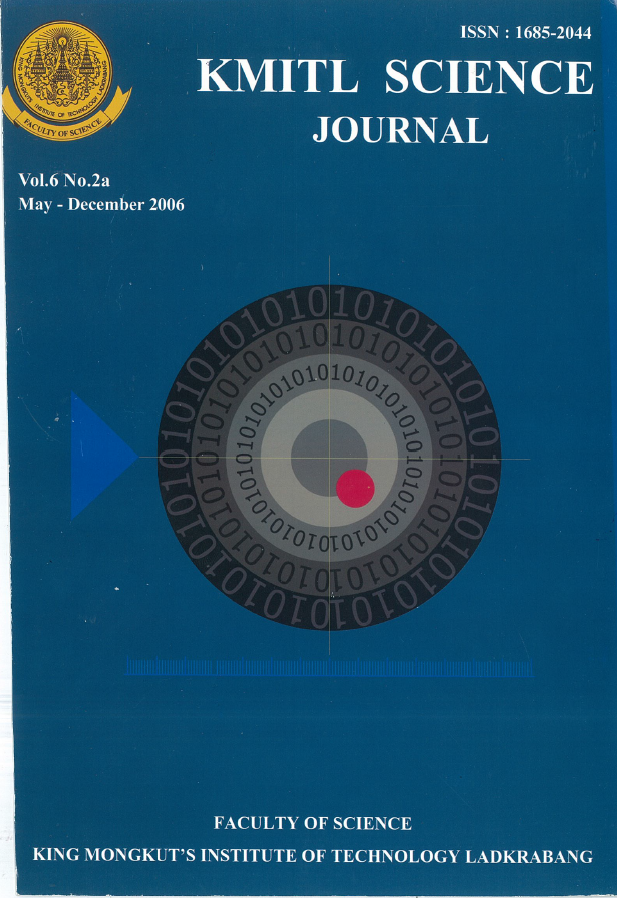Consensus Selection Algorithm for Automatic Primer Design System
Main Article Content
Abstract
The consensus selection is an important process in the primer design system analyzing from sets of protein or nucleotide sequences. An inappropriate consensus can cause poor primers, which can not properly bind to the DNA template. It is time-consuming for experts to select the most appropriate consensus from input alignments. Currently, there are many automatic tools to deal with the primer design problem. But all of them are not compatible and the tool for the template process has not yet been available.
To improve the primer design system, this research proposes three consensus selection algorithms. The first algorithm creates the consensus using DNA backtracking from conserved region. This method gives the most appropriate consensus with the least or non-degeneracy, but can only be used with the protein sequences that had been recorded in GenBank database. The second algorithm groups the consensus by conserved regions to calculating consensus score from the number of degeneracy and consensus length. This algorithm gives high degeneracy consensus with the longest length. The third algorithm groups the consensus islands from conserved regions by the connection of low degeneracy characters and calculating consensus score. This algorithm gives high specific consensus and can be sued with unknown protein sequences.
We integrate these algorithms with the alignments and primer design process in order to create the automatic primer design system that can deal with large protein sequences for designing both PCR primers and probes. Our system includes decision support and primer analysis tools. The pre-version of this automatic primer design system (KUPDS) is available at: http://kupds.com
Keywords: Primer Design, Consensus, Alignment, PCR, Bioinformatics.
Corresponding author: E-mail: fscinws@ku.ac.th
Article Details
Copyright Transfer Statement
The copyright of this article is transferred to Current Applied Science and Technology journal with effect if and when the article is accepted for publication. The copyright transfer covers the exclusive right to reproduce and distribute the article, including reprints, translations, photographic reproductions, electronic form (offline, online) or any other reproductions of similar nature.
The author warrants that this contribution is original and that he/she has full power to make this grant. The author signs for and accepts responsibility for releasing this material on behalf of any and all co-authors.
Here is the link for download: Copyright transfer form.pdf
References
[2] Thompson, J., Higgins, D., and Gibson, T. 1994. CLUSTAL W. Nucleic Acids Res. 22; 4673-4690.
[3] Thompson, J.D., Gibson, T.J., Plewniak, F., Jeanmougin, F. and Higgins, D.G. 1997 CLUSTAL X. Nucleic Acids Res. 25; 4876-4882.
[4] Do, C.B., Mahabhashyam, M.S., Brudno, M., Batzoglou, S. 2005. ProbCons. Genome Res. 15;330-340.
[5] Henikoff, S., Henikoff, J.G., Alford, W.J. and Pietrokovski, S. 1995. Block Maker. Gene. 163; 17-26.
[6] Schuler, G.D., Altschul, S. F., and Lipman, D. J. 1991. A workbench for multiple alignment construction and analysis. Proteins. 9;180-190.
[7] Rose, T.M., Henikoff, J.G. and Henikoff, S. 2003. CODEHOP. Nucleic Acids Res. 31; 3763-3766.
[8] WWW. http://www.bibiserv.techfak.uni-bielefeld.de/genefisher/
[9] Xintao Wei, David N. Kuhn, Giri Narasimhan. 2003. Degenerate Primer Design via Clustering. IEEE Computer Society Bioinformatics Conference (CSB’03), pp.75.
[10] WWW. http://www.PremierBiosoft.com
[11] Rozen, S. and Skaletsky, H. 2000. Primer3. Krawetz, S. and Misener, S. (eds.). Bioformatics Methods and Protocols. Humana Press, Totowa, NJ, pp. 365-386.
[12] WWW.http://www.seq.yeastgenome.org/cgi-bin/web-primer
[13] Li, L-C. and Dahiya, R. 2002. MethPrimer. Bioinformatics. 18; 1427-1431.
[14] Sankoff D., Morel C. and Cedergren RJ. 1973 Evolution of 5S RNA and the non-randomness of base replacement. Nature NewBiol. 245; 232-234.
[15] Linhart, C. and Shamir, R. 2002. The degenerate primer design problem. Bioinformatics. 18 Suppl. 1: S176-S180.


